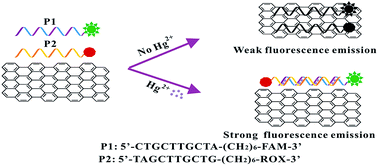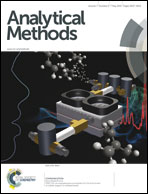Dual color fluorescence quantitative detection of mercury in soil with graphene oxide and dye-labeled nucleic acids†
Abstract
A dual color fluorescence quantitative detection method for Hg2+ in soil has been developed by synchronous fluorescence analysis based on graphene oxide (GO) and dye-labeled nucleic acids. In this strategy, two complementary dye-labeled single-stranded nucleic acids (ssDNAs) with thymine–thymine (T–T) mismatches and GO were employed. Two dyes 6-carboxyfluorescein (FAM) and 6-carboxy-x-rhodamine (ROX) were labeled on 3′ ends of two different ssDNAs, respectively. In the absence of Hg2+, dye-labeled ssDNAs were adsorbed on GO, then the fluorescence of dyes was quenched by GO and the fluorescence signals were very weak. But in the presence of Hg2+, two complementary ssDNAs with T–T mismatches formed double-stranded DNA (dsDNA) via the T–Hg2+–T coordination structure. The formation of dsDNA resulted in the release of dye-labeled ssDNA from GO, and the fluorescence of dyes was restored. The wavelength intervals between the maximum excitation and emission of FAM and ROX are very close, so the fluorescence signals of two dyes can be obtained simultaneously using synchronous fluorescence analysis. Thus, dual color fluorescence quantitative detection of Hg2+ can be realized by simultaneously measuring the fluorescence signals of FAM and ROX, respectively. Under optimum conditions, the total fluorescence intensity of FAM and ROX exhibited a good linear dependence on the Hg2+ concentration in the range from 8 × 10−10 to 8 × 10−8 mol L−1. The fitted regression equation was obtained with a correlation coefficient (R2) of 0.9952 and the detection limit (3σ) of Hg2+ was estimated to be 5 × 10−10 mol L−1. This proposed method can use the total fluorescence intensity of FAM and ROX to realize the quantitative detection of Hg2+, so the detection sensitivity of the analytical method can be greatly improved.


 Please wait while we load your content...
Please wait while we load your content...